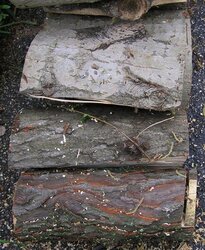This year I decided to try a different fall/spring wood than my usual red maple, and so I picked up a bunch of walnut from freecycle. I know it's walnut, just based on the wood color and because I saw one of the pods left over from fall. But the bark's completely different from the other walnut trees I've seen, which I think were black walnut. I was expecting deep furrowed bark, like black locust, but most of the logs were rather smooth, with only the largest logs having some texture. See the photos; the top two logs in the bark photo are both from the same walnut tree. (Identify the bottom one for extra credit.) Is this english walnut, rather than black walnut? It's a pretty wet wood (freshly cut), so I'll be curious just how light it is after seasoning.
English walnut
- Thread starter DiscoInferno
- Start date
-
Active since 1995, Hearth.com is THE place on the internet for free information and advice about wood stoves, pellet stoves and other energy saving equipment.
We strive to provide opinions, articles, discussions and history related to Hearth Products and in a more general sense, energy issues.
We promote the EFFICIENT, RESPONSIBLE, CLEAN and SAFE use of all fuels, whether renewable or fossil.



